steering INFINITI G-CONVERTIBLE 2012 Workshop Manual
[x] Cancel search | Manufacturer: INFINITI, Model Year: 2012, Model line: G-CONVERTIBLE, Model: INFINITI G-CONVERTIBLE 2012Pages: 474, PDF Size: 3.63 MB
Page 377 of 474

6-10In case of emergency
retailer about obtaining these parts. See
“Changing flat tire (for models with spare
tire)”(P.6-3) for usage of jacking tools and
tire replacement.
Before using emergency tire punc-
ture repair kit
GUID-C994BCD3-EB70-4BE1-AC12-BC734B28D6B8. If any foreign object (for example, a
screw or nail) is embedded in the tire,
do not remove it.
. Check the expiration date of the sealant
(shown on the label attached to the
bottle). Never use a sealant whose
expiration date has passed.
Repairing tireGUID-A73B72D6-D256-48D3-9998-8D39932B0F30
WARNING
Observe the following precautions when
using the tire repair compound.
. Swallowing the compound is dangerous.
Immediately drink as much water as
possible and seek prompt medical as-
sistance.
. Rinse well with lots of water if the
compound comes into contact with skin
or eyes. If irritation persists, seek
prompt medical attention. .
Keep the repair compound out of the
reach of children.
. The emergency repair compound may
cause a malfunction of the tire pressure
sensors and cause the low tire pressure
warning light to illuminate. Have the tire
pressure sensor replaced as soon as
possible.
NOTE:
Do not remove any nails or screws that
have penetrated the tire when performing
repairs.
SCE0867
1. Open the lid of the air compressor and
take out the speed restriction sticker,
then put it in a location where the
driver can see it while driving.
CAUTION
Do not put the speed restriction label on the
steering wheel pad, the speedometer or the
warning light locations.
Page 384 of 474
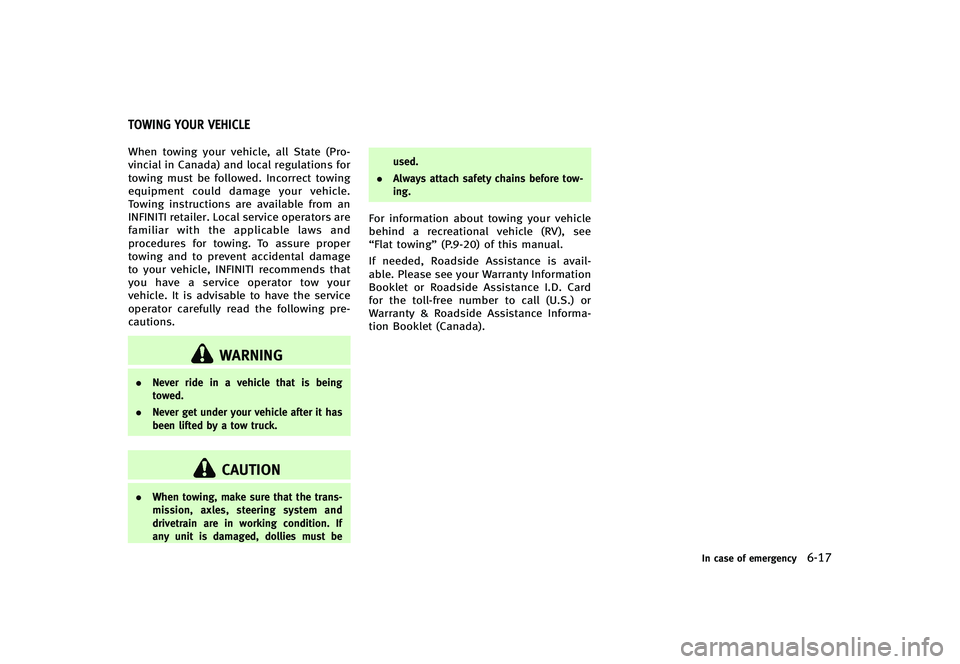
GUID-21B8BD6F-48B4-4339-B478-130F0C147808When towing your vehicle, all State (Pro-
vincial in Canada) and local regulations for
towing must be followed. Incorrect towing
equipment could damage your vehicle.
Towing instructions are available from an
INFINITI retailer. Local service operators are
familiar with the applicable laws and
procedures for towing. To assure proper
towing and to prevent accidental damage
to your vehicle, INFINITI recommends that
you have a service operator tow your
vehicle. It is advisable to have the service
operator carefully read the following pre-
cautions.
WARNING
.Never ride in a vehicle that is being
towed.
. Never get under your vehicle after it has
been lifted by a tow truck.
CAUTION
.When towing, make sure that the trans-
mission, axles, steering system and
drivetrain are in working condition. If
any unit is damaged, dollies must be used.
. Always attach safety chains before tow-
ing.
For information about towing your vehicle
behind a recreational vehicle (RV), see
“Flat towing” (P.9-20) of this manual.
If needed, Roadside Assistance is avail-
able. Please see your Warranty Information
Booklet or Roadside Assistance I.D. Card
for the toll-free number to call (U.S.) or
Warranty & Roadside Assistance Informa-
tion Booklet (Canada).
In case of emergency6-17
TOWING YOUR VEHICLE
Page 385 of 474
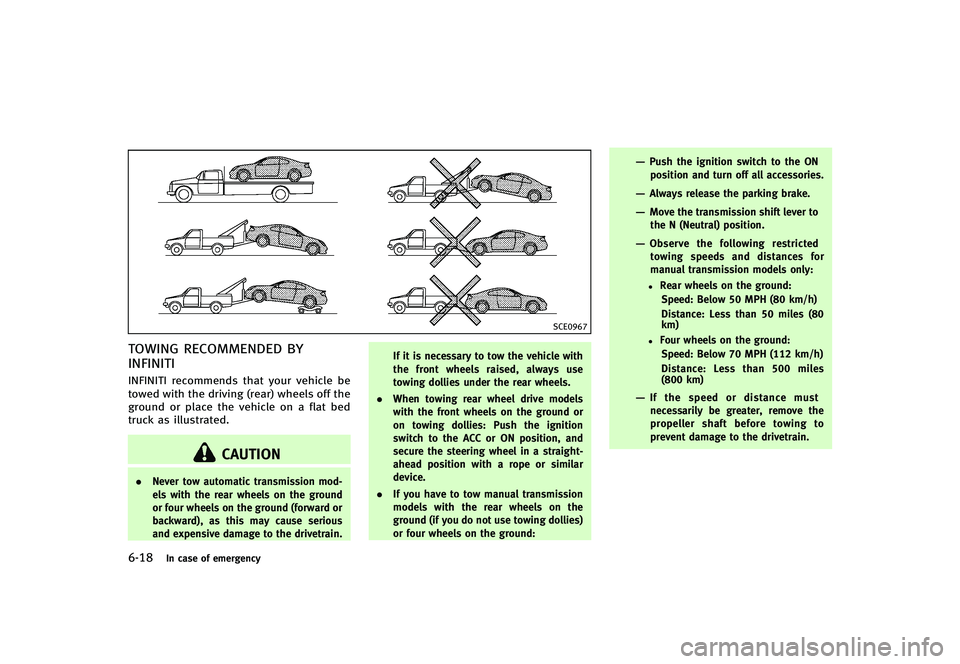
6-18In case of emergency
SCE0967
TOWING RECOMMENDED BY
INFINITI
GUID-ED9538D8-F70E-46EA-B7DC-D0B36C79F2F0INFINITI recommends that your vehicle be
towed with the driving (rear) wheels off the
ground or place the vehicle on a flat bed
truck as illustrated.
CAUTION
.Never tow automatic transmission mod-
els with the rear wheels on the ground
or four wheels on the ground (forward or
backward), as this may cause serious
and expensive damage to the drivetrain. If it is necessary to tow the vehicle with
the front wheels raised, always use
towing dollies under the rear wheels.
. When towing rear wheel drive models
with the front wheels on the ground or
on towing dollies: Push the ignition
switch to the ACC or ON position, and
secure the steering wheel in a straight-
ahead position with a rope or similar
device.
. If you have to tow manual transmission
models with the rear wheels on the
ground (if you do not use towing dollies)
or four wheels on the ground:
—Push the ignition switch to the ON
position and turn off all accessories.
—Always release the parking brake.
—Move the transmission shift lever tothe N (Neutral) position.
—Observe the following restricted
towing speeds and distances for
manual transmission models only:
.Rear wheels on the ground:
Speed: Below 50 MPH (80 km/h)
Distance: Less than 50 miles (80
km)
.Four wheels on the ground:
Speed: Below 70 MPH (112 km/h)
Distance: Less than 500 miles
(800 km)
—If the speed or distance mustnecessarily be greater, remove the
propeller shaft before towing to
prevent damage to the drivetrain.
Page 388 of 474

.Never tow a vehicle using the vehicle tie
downs or recovery hooks.
. Always pull the cable straight out from
the front of the vehicle. Never pull on the
vehicle at an angle.
. Pulling devices should be routed so they
do not touch any part of the suspension,
steering, brake or cooling systems.
. Pulling devices such as ropes or canvas
straps are not recommended for use in
vehicle towing or recovery.
Rocking a stuck vehicleGUID-CAB6F3A9-C000-4766-AEE6-0D0457CAACBAIf your vehicle is stuck in sand, snow, mud,
etc., use the following procedure:
1. Turn off the Vehicle Dynamic Control
(VDC) system.
2. Make sure the area in front and behind the vehicle is clear of obstructions.
3. Turn the steering wheel right and left to clear an area around the front tires.
4. Slowly rock the vehicle forward and backward.
.Shift back and forth between R
(Reverse) and D (Drive) (automatic
transmission models) or 1st and R
(Reverse) (manual transmission models).
.Apply the accelerator as little as
possible to maintain the rocking
motion.
.Release the accelerator pedal beforeshifting between R (Reverse) and D
(Drive) (automatic transmission
models) or 1st and R (Reverse)
(manual transmission models).
.Do not spin the tires above 35 MPH(55 km/h).
5. If the vehicle cannot be freed after a few tries, contact a professional towing
service to remove the vehicle.
In case of emergency6-21
Page 398 of 474
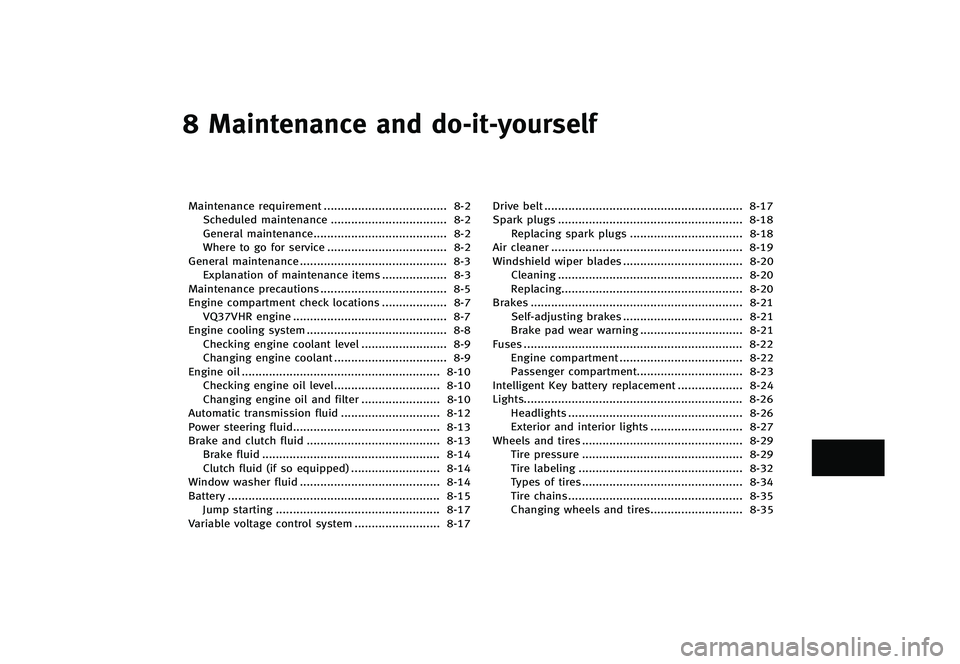
8 Maintenance and do-it-yourself
Maintenance requirement...
.................................... 8-2
Scheduled maintenance ...
.................................. 8-2
General maintenance ...
....................................... 8-2
Where to go for service ...
................................... 8-2
General maintenance ...
........................................... 8-3
Explanation of maintenance items ...
................... 8-3
Maintenance precautions ...
..................................... 8-5
Engine compartment check locations ...
................... 8-7
VQ37VHR engine ...
............................................. 8-7
Engine cooling system ...
......................................... 8-8
Checking engine coolant level ...
......................... 8-9
Changing engine coolant ...
................................. 8-9
Engine oil ...
.......................................................... 8-10
Checking engine oil level ...
............................... 8-10
Changing engine oil and filter ...
....................... 8-10
Automatic transmission fluid ...
............................. 8-12
Power steering fluid ...
........................................... 8-13
Brake and clutch fluid ...
....................................... 8-13
Brake fluid ...
.................................................... 8-14
Clutch fluid (if so equipped) ...
.......................... 8-14
Window washer fluid ...
......................................... 8-14
Battery ...
.............................................................. 8-15
Jump starting ...
................................................ 8-17
Variable voltage control system ...
......................... 8-17 Drive belt
...
.......................................................... 8-17
Spark plugs ...
...................................................... 8-18
Replacing spark plugs ...
................................. 8-18
Air cleaner ...
........................................................ 8-19
Windshield wiper blades ...
................................... 8-20
Cleaning ...
...................................................... 8-20
Replacing ...
..................................................... 8-20
Brakes ...
.............................................................. 8-21
Self-adjusting brakes ...
................................... 8-21
Brake pad wear warning ...
.............................. 8-21
Fuses ...
................................................................ 8-22
Engine compartment ...
.................................... 8-22
Passenger compartment ...
............................... 8-23
Intelligent Key battery replacement ...
................... 8-24
Lights ...
................................................................ 8-26
Headlights ...
................................................... 8-26
Exterior and interior lights ...
........................... 8-27
Wheels and tires ...
............................................... 8-29
Tire pressure ...
............................................... 8-29
Tire labeling ...
................................................ 8-32
Types of tires ...
............................................... 8-34
Tire chains ...
................................................... 8-35
Changing wheels and tires ...
........................... 8-35
Page 400 of 474
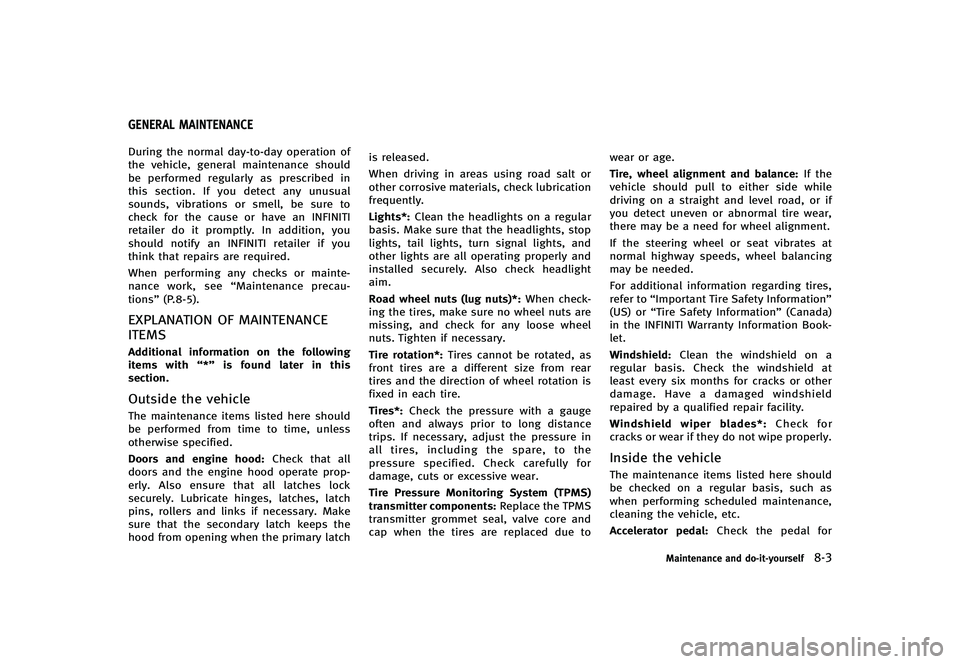
GUID-7E681473-8113-4EFB-B5DA-7A7484E2409FDuring the normal day-to-day operation of
the vehicle, general maintenance should
be performed regularly as prescribed in
this section. If you detect any unusual
sounds, vibrations or smell, be sure to
check for the cause or have an INFINITI
retailer do it promptly. In addition, you
should notify an INFINITI retailer if you
think that repairs are required.
When performing any checks or mainte-
nance work, see“Maintenance precau-
tions” (P.8-5).
EXPLANATION OF MAINTENANCE
ITEMS
GUID-4DADA991-350E-4791-AC1F-B7D348E957C5Additional information on the following
items with “*”is found later in this
section.
Outside the vehicleGUID-935F9711-28E8-44B7-926E-055C6CC77282The maintenance items listed here should
be performed from time to time, unless
otherwise specified.
Doors and engine hood: Check that all
doors and the engine hood operate prop-
erly. Also ensure that all latches lock
securely. Lubricate hinges, latches, latch
pins, rollers and links if necessary. Make
sure that the secondary latch keeps the
hood from opening when the primary latch is released.
When driving in areas using road salt or
other corrosive materials, check lubrication
frequently.
Lights*:
Clean the headlights on a regular
basis. Make sure that the headlights, stop
lights, tail lights, turn signal lights, and
other lights are all operating properly and
installed securely. Also check headlight
aim.
Road wheel nuts (lug nuts)*: When check-
ing the tires, make sure no wheel nuts are
missing, and check for any loose wheel
nuts. Tighten if necessary.
Tire rotation*: Tires cannot be rotated, as
front tires are a different size from rear
tires and the direction of wheel rotation is
fixed in each tire.
Tires*: Check the pressure with a gauge
often and always prior to long distance
trips. If necessary, adjust the pressure in
all tires, including the spare, to the
pressure specified. Check carefully for
damage, cuts or excessive wear.
Tire Pressure Monitoring System (TPMS)
transmitter components: Replace the TPMS
transmitter grommet seal, valve core and
cap when the tires are replaced due to wear or age.
Tire, wheel alignment and balance:
If the
vehicle should pull to either side while
driving on a straight and level road, or if
you detect uneven or abnormal tire wear,
there may be a need for wheel alignment.
If the steering wheel or seat vibrates at
normal highway speeds, wheel balancing
may be needed.
For additional information regarding tires,
refer to “Important Tire Safety Information”
(US) or “Tire Safety Information” (Canada)
in the INFINITI Warranty Information Book-
let.
Windshield: Clean the windshield on a
regular basis. Check the windshield at
least every six months for cracks or other
damage. Have a damaged windshield
repaired by a qualified repair facility.
Windshield wiper blades*: Check for
cracks or wear if they do not wipe properly.
Inside the vehicleGUID-AAA8A546-692D-407E-9E98-33BD16F490A2The maintenance items listed here should
be checked on a regular basis, such as
when performing scheduled maintenance,
cleaning the vehicle, etc.
Accelerator pedal: Check the pedal for
Maintenance and do-it-yourself8-3
GENERAL MAINTENANCE
Page 401 of 474
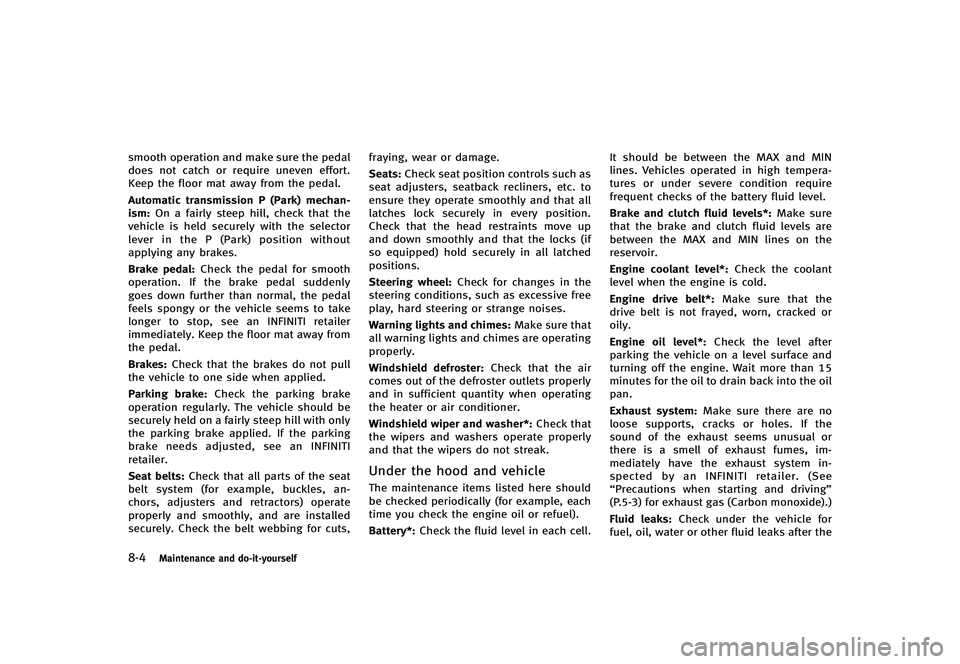
8-4Maintenance and do-it-yourself
smooth operation and make sure the pedal
does not catch or require uneven effort.
Keep the floor mat away from the pedal.
Automatic transmission P (Park) mechan-
ism:On a fairly steep hill, check that the
vehicle is held securely with the selector
lever in the P (Park) position without
applying any brakes.
Brake pedal: Check the pedal for smooth
operation. If the brake pedal suddenly
goes down further than normal, the pedal
feels spongy or the vehicle seems to take
longer to stop, see an INFINITI retailer
immediately. Keep the floor mat away from
the pedal.
Brakes: Check that the brakes do not pull
the vehicle to one side when applied.
Parking brake: Check the parking brake
operation regularly. The vehicle should be
securely held on a fairly steep hill with only
the parking brake applied. If the parking
brake needs adjusted, see an INFINITI
retailer.
Seat belts: Check that all parts of the seat
belt system (for example, buckles, an-
chors, adjusters and retractors) operate
properly and smoothly, and are installed
securely. Check the belt webbing for cuts, fraying, wear or damage.
Seats:
Check seat position controls such as
seat adjusters, seatback recliners, etc. to
ensure they operate smoothly and that all
latches lock securely in every position.
Check that the head restraints move up
and down smoothly and that the locks (if
so equipped) hold securely in all latched
positions.
Steering wheel: Check for changes in the
steering conditions, such as excessive free
play, hard steering or strange noises.
Warning lights and chimes: Make sure that
all warning lights and chimes are operating
properly.
Windshield defroster: Check that the air
comes out of the defroster outlets properly
and in sufficient quantity when operating
the heater or air conditioner.
Windshield wiper and washer*: Check that
the wipers and washers operate properly
and that the wipers do not streak.
Under the hood and vehicleGUID-6687B186-528E-4C5C-A54D-1DCA274537D4The maintenance items listed here should
be checked periodically (for example, each
time you check the engine oil or refuel).
Battery*: Check the fluid level in each cell. It should be between the MAX and MIN
lines. Vehicles operated in high tempera-
tures or under severe condition require
frequent checks of the battery fluid level.
Brake and clutch fluid levels*:
Make sure
that the brake and clutch fluid levels are
between the MAX and MIN lines on the
reservoir.
Engine coolant level*: Check the coolant
level when the engine is cold.
Engine drive belt*: Make sure that the
drive belt is not frayed, worn, cracked or
oily.
Engine oil level*: Check the level after
parking the vehicle on a level surface and
turning off the engine. Wait more than 15
minutes for the oil to drain back into the oil
pan.
Exhaust system: Make sure there are no
loose supports, cracks or holes. If the
sound of the exhaust seems unusual or
there is a smell of exhaust fumes, im-
mediately have the exhaust system in-
spected by an INFINITI retailer. (See
“Precautions when starting and driving”
(P.5-3) for exhaust gas (Carbon monoxide).)
Fluid leaks: Check under the vehicle for
fuel, oil, water or other fluid leaks after the
Page 402 of 474

vehicle has been parked for a while. Water
dripping from the air conditioner after use
is normal. If you should notice any leaks or
if gasoline fumes are evident, check for the
cause and have it corrected immediately.
Power steering fluid level* and lines:
Check the level with the engine off. Check
the lines for proper attachment, leaks,
cracks, etc.
Radiator and hoses:Check the front of the
radiator and clean off any dirt, insects,
leaves, etc., that may have accumulated.
Make sure the hoses have no cracks,
deformation, rot or loose connections.
Underbody: The underbody is frequently
exposed to corrosive substances such as
those used on icy roads or to control dust.
It is very important to remove these
substances, otherwise rust will form on
the floor pan, frame, fuel lines and around
the exhaust system. At the end of winter,
the underbody should be thoroughly
flushed with plain water, being careful to
clean those areas where mud and dirt may
accumulate. For additional information,
see “Cleaning exterior” (P.7-2).
Windshield washer fluid*: Check that there
is adequate fluid in the reservoir.
GUID-10AF39EE-6E4C-416A-9D4D-B725EAC05CA0When performing any inspection or main-
tenance work on your vehicle, always take
care to prevent serious accidental injury to
yourself or damage to the vehicle. The
following are general precautions which
should be closely observed.
WARNING
. Park the vehicle on a level surface, apply
the parking brake securely and block the
wheels to prevent the vehicle from
moving. For manual transmission mod-
els, move the shift lever to N (Neutral).
For automatic transmission models,
move the selector lever to P (Park).
. Be sure the ignition switch is in the OFF
or LOCK position when performing any
parts replacement or repairs.
. Never connect or disconnect the battery
or any transistorized component while
the ignition switch is in the ON position.
. Never leave the engine or automatic
transmission related component har-
nesses disconnected while the ignition
switch is in the ON position.
. If you must work with the engine
running, keep your hands, clothing, hair and tools away from moving fans, belts
and any other moving parts.
. It is advisable to secure or remove any
loose clothing and remove any jewelry,
such as rings, watches, etc. before
working on your vehicle.
. Always wear eye protection whenever
you work on your vehicle.
. If you must run the engine in an
enclosed space such as a garage, be
sure there is proper ventilation for
exhaust gases to escape.
. Never get under the vehicle while it is
supported only by a jack. If it is
necessary to work under the vehicle,
support it with safety stands.
. Keep smoking materials, flame and
sparks away from fuel tank and the
battery.
. Your vehicle is equipped with an auto-
matic engine cooling fan. It may come on
at any time without warning, even if the
ignition key is in the OFF position and
the engine is not running. To avoid
injury, always disconnect the negative
battery cable before working near the
fan.
Maintenance and do-it-yourself8-5
MAINTENANCE PRECAUTIONS
Page 404 of 474
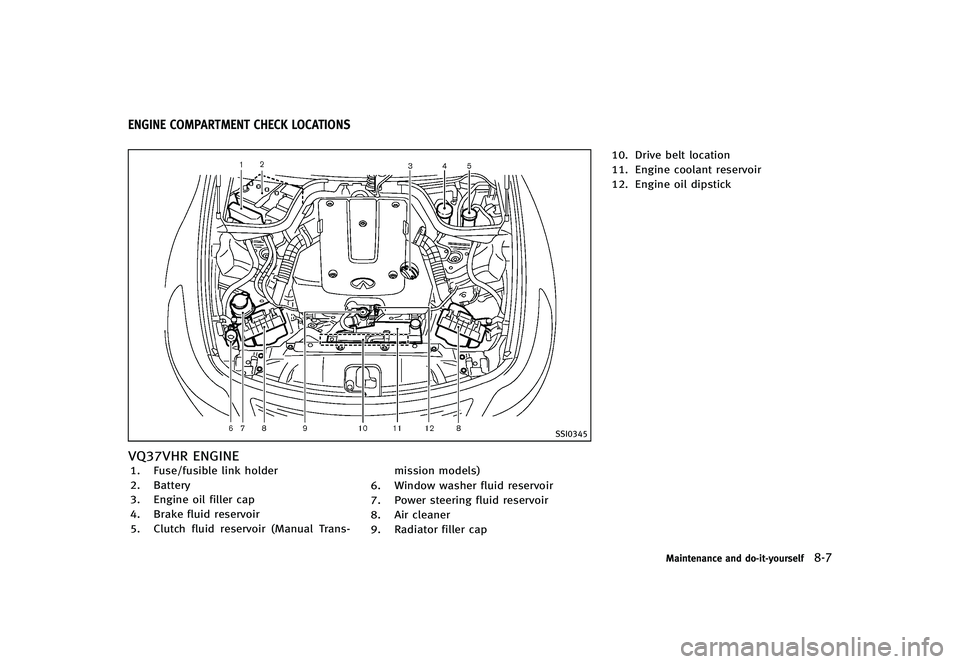
GUID-525850E4-370C-413C-8AEB-A266E40A1898
SSI0345
VQ37VHR ENGINEGUID-A979648E-87A1-4FAB-A735-8E8F3227852A1. Fuse/fusible link holder
2. Battery
3. Engine oil filler cap
4. Brake fluid reservoir
5. Clutch fluid reservoir (Manual Trans-mission models)
6. Window washer fluid reservoir
7. Power steering fluid reservoir
8. Air cleaner
9. Radiator filler cap 10. Drive belt location
11. Engine coolant reservoir
12. Engine oil dipstick
Maintenance and do-it-yourself8-7
ENGINE COMPARTMENT CHECK LOCATIONS
Page 410 of 474

GUID-E6349F5A-30CB-464F-9C20-522FC0ACF05D
SDI1765A
Check the fluid level in the reservoir.
The fluid level should be checked with the
engine off using the HOT range (
*1: HOT
MAX.,
*2: HOT MIN.) at fluid temperatures
of 122 to 1768F (50 to 808C) or using the
COLD range (
*3: COLD MAX.,*4: COLD
MIN.) at fluid temperatures of 32 to 868F (0
to 308C).
If the fluid is below the MIN line, add
Genuine NISSAN PSF or equivalent. Re-
move the cap and fill through the opening.
CAUTION
. Do not overfill.
. Use Genuine NISSAN PSF or equivalent.
GUID-1D2EA3BC-D20D-4834-8E55-D17790F6C116For further brake and clutch fluid informa-
tion, see “Capacities and recommended
fuel/lubricants” (P.9-2) of this manual.
WARNING
.Use only new fluid from a sealed
container. Old, inferior or contaminated
fluid may damage the brake system. The
use of improper fluids can damage the
brake system and affect the vehicle’s
stopping ability.
. Be sure to clean the filler cap before
removing.
. Brake fluid is poisonous and should be
stored carefully in marked containers out
of the reach of children.
CAUTION
Do not spill the fluid on painted surfaces.
This will damage the paint. If fluid is spilled,
wash the surface with water.
Maintenance and do-it-yourself8-13
POWER STEERING FLUID BRAKE AND CLUTCH FLUID